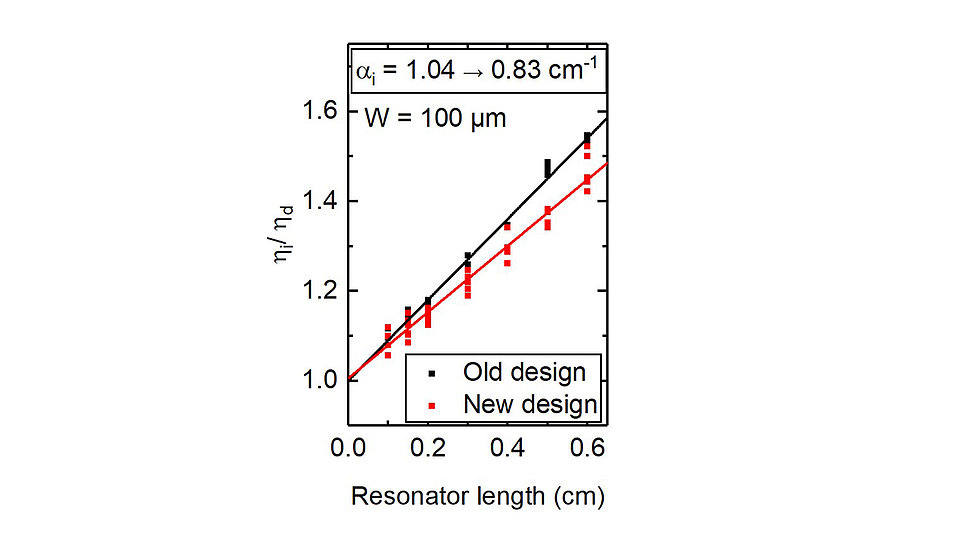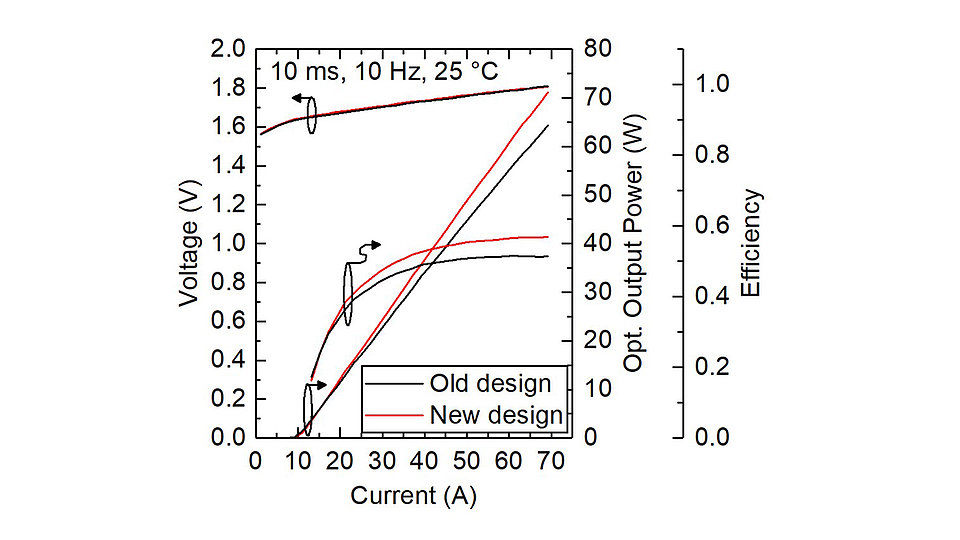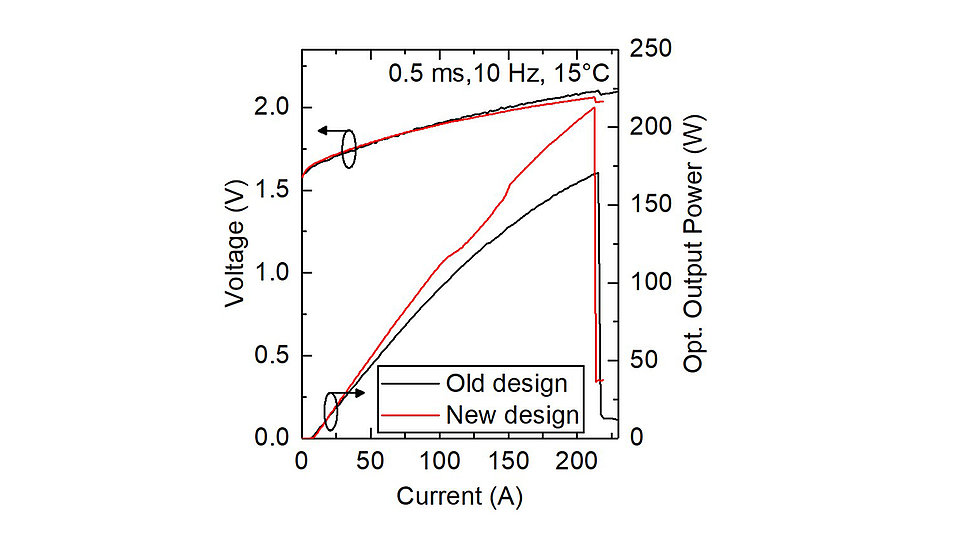Vertical design improvement in high-power 780 nm pumps for high-energy class mid infra-red lasers
Fig. 2: Voltage, power and efficiency as a function of current for a 10 ms pulse and 10 Hz repetition rate at a heatsink temperature of 25 °C
High-energy-class pulsed solid-state lasers are of increasing interest in applications in plasma acceleration as well as in detection and atmospheric sensing. Thulium-doped solid-state lasers (e.g. Th:YAG) can be efficiently pumped using diode lasers emitting around 780 nm. Diode lasers with high output power and efficiency are sought to reduce cost, and high duty cycle pumping is needed for high-energy class applications [1].
In the past, FBH increased the output power of the conventional single emitters (W = 90…100 µm) from 4 W to 60 W at high duty cycle (10 %) and long pulse length (10 ms) using large aperture (W = 1200 µm) single emitters mounted between expansion-matched heatsinks, at the cost of reduced operating efficiency (from 60 % to 50 %), as presented at SPIE Photonics West, 2020 [2].
In recent studies, FBH scientists investigated the advantage of an alternative epitaxial layer design for increased peak power and efficiency, focusing on wide-aperture single emitters with W = 1200 µm. A significant increase in power and efficiency was successfully achieved. The epitaxial design uses GaAsxP1-x active region and AlyGa1-yAs waveguide and cladding layers. In contrast to the previous design, thin p-side waveguide and cladding layers and high Al content in p-side waveguide and cladding were used to increase the vertical asymmetry for lower internal optical loss and vertical leakage.
In a first step, standard symmetric and newly developed asymmetric vertical designs were grown using metalorganic vapor phase epitaxy (MOVPE) and fabricated into broad area lasers (BALs) using standard techniques. The devices were fabricated with W = 100 µm stripe width and various resonator lengths (L) for length-dependent analysis to determine internal efficiency and internal loss for both designs.
Fig. 1 shows inverse external differential efficiency scaled with internal efficiency, ηi/ηd (to clearly show the difference in optical loss) as a function of L for both designs. The internal optical loss, αi, and ηi are determined from a linear fit to the 1/ ηd- L characteristics. αi is reduced from 1.04 to 0.83 cm-1 using the asymmetric vertical design, while ηi is ~95 % for both designs.
In a second step, diode lasers with L = 6 mm were fabricated using symmetric and asymmetric designs, followed by facet cleaving and passivation. The front and rear facets of lasers are next coated with dielectric layers, with Rf = 0.8 % and Rr = 98 % reflectivity, respectively. All devices were mounted using an expansion-matched sandwich heatsink. The high duty cycle performance of devices was measured using 10 ms pulse and 10 Hz repetition rate at a heatsink temperature of 25 °C, and a peak power measurement was performed using 0.5 ms pulse and 10 Hz repetition rate at a heatsink temperature of 15 °C.
In Fig. 2, high duty cycle voltage-power-efficiency-current characteristics of the asymmetric design are compared with those of the symmetric design. Applying the new asymmetric vertical design increases ηE from 50 % to 57 % for output power Pout > 60 W by increasing the slope efficiency due to lower optical losses. Fig. 3 shows the voltage and output power as a function of current for peak power testing. The asymmetric design also scales up the peak power of the devices from 172 W to 213 W, by minimizing power saturation effects. The power of all devices suddenly drops due to the catastrophic optical mirror damage (COMD). The ongoing increases power and efficiency helps to ensure that these devices will continue to play an important role in future solid-state laser systems.
A detailed review of these results will be presented in October 2021 at the IEEE Photonics Conference (online) [3].
Funding was provided within the KMU-NetC Program as part of the Federal Ministry of Education and Research (BMBF) project HECMIR (FKZ:03VNE2068E).
Publications
[1] M. Hübner, M. Wilkens, B. Eppich, A. Maaßdorf, D. Martin, A. Ginolas, P. S. Basler, and P. Crump, “A 1.4 kW 780 nm pulsed diode laser, high duty cycle, passively side-cooled pump module”, Optics Express 29 (7), pp. 9749-9757, 2021.
[2] P. Crump, M. Wilkens, M. Hübner, S. Arslan, M. Niemeyer, P. S. Basler, D. Martin, A. Maaßdorf, A. Ginolas, and G. Tränkle, “Efficient, high power 780 nm pumps for high energy class MIR solid state lasers”, Proc. SPIE, 11262, 1126204 (2020).
[3] S. Arslan,D. Martin,P. Della Casa, A. Ginolas and P. A. Crump, "Progress in high power diode laser pumps for high-energy class mid infra-red lasers", Proc. IEEE Photonics Conference (IPC), 2021 (Invited talk).


